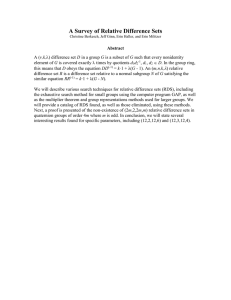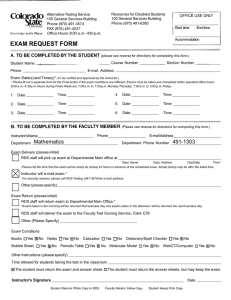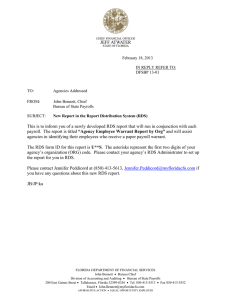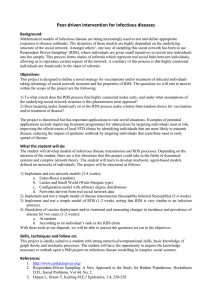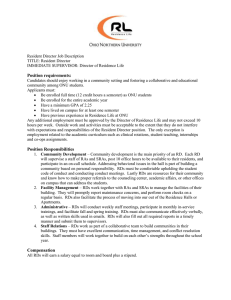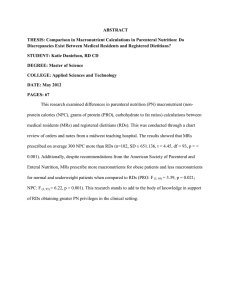PS specification - updated RDS Standard
advertisement
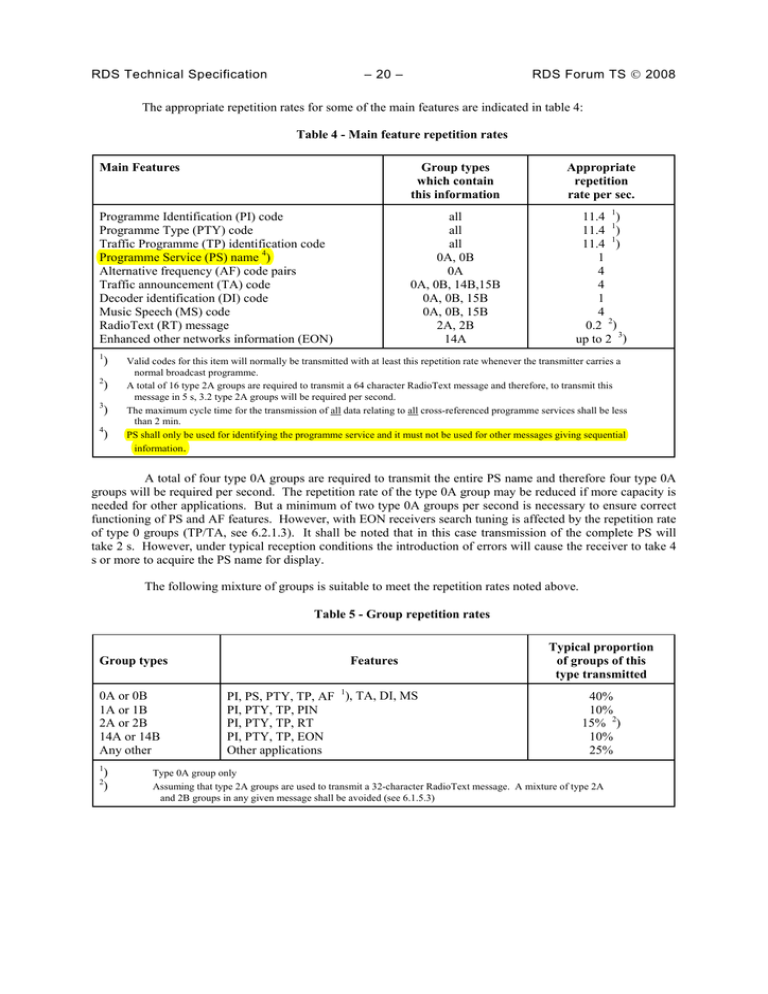
RDS Technical Specification RDS Forum TS © 2008 – 20 – The appropriate repetition rates for some of the main features are indicated in table 4: Table 4 - Main feature repetition rates Main Features Group types which contain this information Appropriate repetition rate per sec. Programme Identification (PI) code Programme Type (PTY) code Traffic Programme (TP) identification code Programme Service (PS) name 4) Alternative frequency (AF) code pairs Traffic announcement (TA) code Decoder identification (DI) code Music Speech (MS) code RadioText (RT) message Enhanced other networks information (EON) all all all 0A, 0B 0A 0A, 0B, 14B,15B 0A, 0B, 15B 0A, 0B, 15B 2A, 2B 14A 11.4 1) 11.4 1) 11.4 1) 1 4 4 1 4 0.2 2) up to 2 3) 1 ) 2 ) 3 ) 4 ) Valid codes for this item will normally be transmitted with at least this repetition rate whenever the transmitter carries a normal broadcast programme. A total of 16 type 2A groups are required to transmit a 64 character RadioText message and therefore, to transmit this message in 5 s, 3.2 type 2A groups will be required per second. The maximum cycle time for the transmission of all data relating to all cross-referenced programme services shall be less than 2 min. PS shall only be used for identifying the programme service and it must not be used for other messages giving sequential information. A total of four type 0A groups are required to transmit the entire PS name and therefore four type 0A groups will be required per second. The repetition rate of the type 0A group may be reduced if more capacity is needed for other applications. But a minimum of two type 0A groups per second is necessary to ensure correct functioning of PS and AF features. However, with EON receivers search tuning is affected by the repetition rate of type 0 groups (TP/TA, see 6.2.1.3). It shall be noted that in this case transmission of the complete PS will take 2 s. However, under typical reception conditions the introduction of errors will cause the receiver to take 4 s or more to acquire the PS name for display. The following mixture of groups is suitable to meet the repetition rates noted above. Table 5 - Group repetition rates Group types 0A or 0B 1A or 1B 2A or 2B 14A or 14B Any other 1 2 ) ) Features PI, PS, PTY, TP, AF 1), TA, DI, MS PI, PTY, TP, PIN PI, PTY, TP, RT PI, PTY, TP, EON Other applications Typical proportion of groups of this type transmitted 40% 10% 15% 2) 10% 25% Type 0A group only Assuming that type 2A groups are used to transmit a 32-character RadioText message. A mixture of type 2A and 2B groups in any given message shall be avoided (see 6.1.5.3) RDS TS – Message format 6.1.5 – 23 – RDS Forum TS © 2008 Coding of the Group types 6.1.5.1 Type 0 groups: Basic tuning and switching information The repetition rates of type 0 groups must be chosen in compliance with 6.1.3. Figure 12 shows the format of type 0A groups and figure 13 the format of type 0B groups. DI C1 C0 Figure 12 - Basic tuning and switching information - Type 0A group Figure 13 - Basic tuning and switching information - Type 0B group Type 0A groups are usually transmitted whenever alternative frequencies exist. Type 0B groups without any type 0A groups may be transmitted only when no alternative frequencies exist. There are two methods (A and B) for transmission of alternative frequencies (see 6.2.1.6.2). The Programme Service name comprises eight characters, intended for static display on a receiver. It is the primary aid to listeners in programme service identification and selection. The use of PS to transmit text other than a single eight character name is not permitted (see also 6.2.2). Transmission of a PS name usually takes four type 0A groups, but to allow an instant display of the PS when a receiver pre-set is selected, the PS name is often stored for subsequent recall from memory when a programme service is selected. For this reason PS shall generally be invariant. RDS Technical Specification – 24 – RDS Forum TS © 2008 If a broadcaster wishes to transmit longer Programme Service names, programme-related information or any other text, then RadioText provides this feature. Notes on Type 0 groups: 1. Version B differs from version A only in the contents of block 3, the offset word in block 3, and, of course, the version code B0 2. For details of Programme Identification (PI), Programme Type (PTY) and Traffic Programme (TP) code, see figure 9, 6.2.1 and annexes D and F. 3. TA = Traffic announcement code (1 bit) (see 6.2.1.3). 4. MS = Music Speech switch code (1 bit) (see 6.2.1.4). 5. DI= Decoder-identification control code (4 bits) (see 6.2.1.5). This code is transmitted as 1 bit in each type 0 group. The Programme Service name and DI segment address code (C1 and C0 ) serves to locate these bits in the DI codeword. Thus in a group with C1C0 = ‘00’ the DI bit in that group is d3 . These code bits are transmitted most significant bit (d3 ) first. 6. Alternative frequency codes (2 x 8 bits) (see 6.2.1.6). 7. Programme Service name (for display) is transmitted as 8-bit characters as defined in the 8bit code-table E.1 in annex E. Eight characters (including spaces) are allowed for each network and are transmitted as a 2-character segment in each type 0 group. These segments are located in the displayed name by the code bits C1 and Co in block 2. The addresses of the characters increase from left to right in the display. The most significant bit (b7) of each character is transmitted first. RDS Technical Specification – 52 – RDS Forum TS © 2008 6.2.2 Coding and use of information for display The code table E.1 for the displayed 8-bit text characters (basic character set) relating to the Programme Service name, RadioText, Programme Type Name and alphanumeric Radio Paging is given in annex E. As an alternative to RadioText RT with the basic character set an enhanced Radiotext eRT with an extended character set given in table E.2 (see annex E) may be used. The coding for eRT is detailed in annex Q. It is an ODA. The Programme Service name comprises eight characters, intended for static display on a receiver. It is the primary aid to listeners in programme service identification and selection. The use of PS to transmit text other than a single eight character name is not permitted (see also 6.1.5.1). Transmission of a PS name usually takes four type 0A groups, but to allow an instant display of the PS when a receiver pre-set is selected, the PS name is often stored for subsequent recall from memory when a programme service is selected. The transmission and reception conditions for PS described were designed on the basis that PS would generally be invariant. A few transmission operators have allowed PS to change to reflect the origin of the service, for example when a regional service switches to a national service. These changes which may occur a few times a day and have a duration of anything between a few minutes and several hours, are acceptable, but any other dynamic changes to PS are NOT acceptable and may cause a safety hazard by distracting a vehicle driver. A similar effect could be experienced with dynamic text transmission of PTYN. As a result, dynamic PS and PTYN transmissions are expressly forbidden. Similarly RT and eRT could also be distracting to a vehicle driver; therefore the in-vehicle display of RT and eRT should normally be disabled and the RT/eRT display should be designed for end-user viewing only, when manually enabled. 6.2.3 Coding of Clock Time and date (CT) The transmitted clock-time and date shall be accurate; otherwise CT shall not be transmitted. In order to avoid ambiguity when radio-data broadcasts from various sources are processed at one point (e.g. reception from multiple time zones), and to allow calculations of time intervals to be made independent of time zones and summer-time discontinuities, the broadcast time and date codes will use Coordinated Universal Time (UTC) and Modified Julian Day (MJD). A coded local time-difference, expressed in multiples of halfhours is appended to the time and date codes. Conversion between the Modified Julian Day date and UTC time codes and the various calendar systems (e.g. year, month, day, or year, week number, day of week) can be accomplished quite simply by processing in the receiver decoder (see annex G). 6.2.4 Coding of information for Transparent Data Channels (TDC) The coding of this information may be decided unilaterally by the operator, to suit the application. Consumer RDS receivers may provide an output of it (e.g. on a serial or USB interface) for an external device (e.g. a personal computer). 6.2.5 Coding of information for In House applications (IH) The coding of this information may be decided unilaterally by the broadcaster to suit the application. Consumer RDS receivers shall entirely ignore this information. RDS Technical Specification – 58 – RDS Forum TS © 2008 As the PI has a unique value in each area, it may be thought of as a ‘primary key’ to which all other RDS parameters about a particular service are referenced. For this reason, the PI code appears in every RDS group type, and when referring to other services as in EON. Short-range transmitting devices connected to audio sources, when additionally using RDS features, require also the use of a specific PI code. The PI code element structure is defined in annex D. 7.11 Programme Item Number (PIN) The code shall enable receivers and recorders designed to make use of this feature to respond to the particular programme item(s) that the user has preselected. Use is made of the scheduled programme time, to which is added the day of the month in order to avoid ambiguity (see 6.2.1.7). 7.12 Programme Service name (PS) This is the label of the programme service consisting of not more than eight alphanumeric characters coded in accordance with annex E – table E.1, which is displayed by RDS receivers in order to inform the listener what programme service is being broadcast by the station to which the receiver is tuned (see 6.1.5.1). An example for a name is ‘Radio 21’. The Programme Service name is not intended to be used for automatic search tuning and must not be used for giving sequential information. 7.13 Programme TYpe (PTY) This is an identification number to be transmitted with each programme item and which is intended to specify the current Programme Type within 31 possibilities (see annex F). This code could be used for search tuning. The code will, moreover, enable suitable receivers and recorders to be pre-set to respond only to programme items of the desired type. The last number, i.e. 31, is reserved for an alarm identification which is intended to switch on the audio signal when a receiver is operated in a waiting reception mode. 7.14 Programme TYpe Name (PTYN) The PTYN feature is used to further describe current PTY. PTYN permits the display of a more specific PTY description that the broadcaster can freely decide (eg PTY=4: Sport and PTYN: Football ). The PTYN is not intended to change the default eight characters of PTY which will be used during search or wait modes, but only to show in detail the programme type once tuned to a programme. If the broadcaster is satisfied with a default PTY name, it is not necessary to use additional data capacity for PTYN. The Programme Type Name is not intended to be used for automatic PTY selection and must not be used for giving sequential information.
